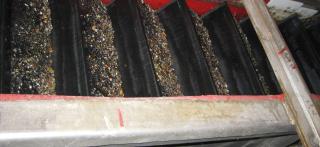
HeadCell Project Wins DBIA Award of Excellence
Atlanta's R.M. Clayton WRF HeadCell-Based Headworks Upgrade Project Awarded Top Honors in Design-Build.
Each year the Design Build Institute of America (DBIA) selects the best large-scale Design-Build projects in the United States in a wide variety of infrastructure categories. Atlanta, Georgia’s R.M. Clayton Water Reclamation Facility (WRF) headworks upgrade project featuring HeadCell® grit separation won the coveted 2018 DBIA National Excellence Award in the Water and Wastewater category.
A Plant Plagued by Grit
The City of Atlanta constructed the R.M. Clayton WRF in 1935 along the banks of the Chattahoochee River. The facility provides wastewater treatment primarily for the northern part of Atlanta and most of northern DeKalb County. The plant was designed to treat an average flow of 122 Mgal/d (462 MLD) and a peak instantaneous flow of 250 Mgal/d (946 MLD). Due to an ineffective Mechanically Induced Vortex (MIV) grit removal system their plant had been plagued by poor performance which for years had led to frequent and expensive mechanical issues throughout their entire plant. After heavy rains, the plant was often forced to completely stop operation of their primary sludge dewatering centrifuges to prevent the heavy grit load from damaging them.
Wet Weather Events Significantly Increased Flows
While the majority of suburban Atlanta has a separated sewer system, the core downtown area has 13 square miles (34 km2) of combined sewer. Atlanta averages around 50 inches (1.3 m) of rain each year and a disproportionate amount of that rainfall comes during several heavy storms. When big storms hit Atlanta, it caused massive problems for the plant. Flows would rapidly spike from an average of around 80-120 Mgal/d (303-454 MLD) to to a whopping 320 Mgal/d (1,211 MLD).
These storm-induced flows would scour all the grit deposited in pipes and channels throughout the entire downtown sewer network to hit the R.M. Clayton plant all at once. Not only would the plant have to deal with 3 (or more) times the average flow during storms, there was an exponentially increased amount of grit contained in those elevated flows.
A Long History of Grit Problems
After struggling with incessant grit loading for many years the plant “upgraded” to mechanically induced vortex (MIV) grit removal in 2000. Despite installing MIV systems, the plant continued to have severe grit problems that were creating maintenance nightmares in all their downstream processes.
Their mechanically induced vortex system provided woefully inadequate protection. Nearly every time a storm hit the MIVs were rapidly overwhelmed. Continuing population growth in the area was only making the problem worse. Once the MIVs were down, all the grit from three trunk sewer lines would flow through the entire treatment works and would ravage nearly every downstream process.
Grit would blanket the primary clarifiers. Anaerobic digesters, biological nutrient removal (BNR) and tertiary filters were all getting clogged with grit. Their grit problem was causing the plant to be more frequently unable to adequately treat their peak flows. This was leading to increasingly frequent expensive discharge violations into the Chattahoochee River.
A Very Challenging Upgrade
This major headworks expansion required keeping the plant online for the entire 18-month project, even during the same challenging peak flow conditions that had prompted the need for the upgrade. R.M. Clayton is bordered by residential neighborhoods and the Chattahoochee River, leaving very little land available for expansion. Compounding this, the limited space they had was constrained by a steep hillside that presented challenging geological issues that made any expansion extremely expensive. A small footprint solution with the capacity to handle their flows was a critical consideration in grit system selection.
Brown & Caldwell partnered with Western Summit Constructors, Inc. to tackle this complicated design-build project at one of the largest wastewater treatment plants in the Southeast. The total project design and construction costs were $53.9 million. With a project this large and design-build accountability on the line, equipment performance was paramount.
Performance Testing, Verification & Validation
There are no standardized methods for testing grit removal performance which creates the potential for skewed performance results based on misrepresentative testing methodologies.
Having been burned by the failure of the MIV systems since 2000, the plant and the design-build team weren’t willing to take any manufacturer’s performance claims on faith. With this much on the line, the engineer thoroughly evaluated all proposed grit testing methodologies and demanded ironclad performance guarantees before considering any type of equipment purchase. Both grit testing methodologies and performance guarantees became critical decision-making criteria.
Their Decision
After detailed evaluation of various manufacturer’s grit testing methods and analysis of the wording of performance guarantees Hydro International’s offering on a HeadCell® based grit separation system was found to best match their criteria and was selected to be installed and tested. Twelve 12’ (3.7 m) twelve-tray HeadCell® systems were installed, and as the contract required each individual HeadCell® was tested by an independent third party under all operating conditions. Each HeadCell® passed all required testing scenarios and continues to eliminate the frequent grit related catastrophes that the plant used to so frequently experience with their inadequate MIV grit removal.
A Resounding Success
As a result of the resounding success of this challenging design-build project, it won the coveted National Excellence Award in the Water and Wastewater category from the Design Build Institute of America for 2018’s Best Design-Build Projects in the United States.
Furthermore, the phenomenal performance of their HeadCell® based upgrade has allowed the plant to upgrade their peak treatment capacity from 250 to 320 MGD (946 to 1,211 MLD).
Click here to view the full DBIA article.

























